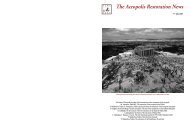τεύχος περιλήψεων - ΥΣΜΑ
τεύχος περιλήψεων - ΥΣΜΑ
τεύχος περιλήψεων - ΥΣΜΑ
You also want an ePaper? Increase the reach of your titles
YUMPU automatically turns print PDFs into web optimized ePapers that Google loves.
6TH INTERNATIONAL MEETING FOR THE RESTORATION OF THE ACROPOLIS MONUMENTS - ABSTRACTS 33<br />
THE DOCUMENTATION OF THE RESTORATION WORKS ON THE ACROPOLIS MONUMENTS<br />
AND ITS DIGITAL MANAGEMENT<br />
E. Lembidaki, Archaeologist, Ph.D. Head of the Documentation Office, YSMA<br />
The use of Information Technology in the management of the documentation from the restoration<br />
interventions carried out on the Acropolis was introduced by ESMA in the 1990s and has<br />
been systematically developed by the newly created Documentation Office of the Acropolis<br />
Restoration Service (YSMA) between 2000-2013. Since 1997 the Database Management System<br />
facilitates the digital management of all documents produced during the restoration and conservation<br />
works from 1975 onwards. Currently, the database contains approximately 136,000<br />
records. The application facilitates the presentation of selected architectural members or larger<br />
parts of the monuments with all the information concerning their state of preservation and the<br />
interventions that are performed on each of them. In this sense, it constitutes a powerful tool for<br />
monitoring and supporting the works that can be used for research and also for the publication<br />
of the final reports on the completed restoration programs, while ensuring the preservation of the<br />
original documents. Since 2001, the installation of workstations in the work-sites has enabled the<br />
immediate, systematic entry of records into the database by archaeologists responsible for the<br />
documentation. Between 2007 and 2009 the database has been redesigned and adapted to the<br />
current demands that were formulated by its use. In the context of the NSRF, the system is further<br />
upgraded, while the user interface is extended to incorporate an environment for the three-dimensional<br />
visualization of the monuments, where interventions are recently completed.<br />
At the same time, the use of digital technology is rapidly expanding to the management of<br />
additional collections of the archive (such as digital drawings, audiovisual material, day-books,<br />
restoration reports and studies). Furthermore, it provides the means for developing new activities,<br />
such as the website of the Acropolis Restoration Service and the virtual tour of the Acropolis monuments.<br />
Scheduled under the framework of the Digital Convergence Programme is the digitization<br />
of past conventional material (publications, handwritten day-books, films and raw footage of<br />
the works), as well as the pilot project for incorporating digital content from the Acropolis Restoration<br />
Service archive into an open-access repository, with the ultimate goal of promoting the material<br />
and communicating the course of the restoration works to the public. The provision for<br />
housing the archive of the Acropolis Restoration Service at the historical building known as “the<br />
Kolettis House” on 13 Polygnotou Str., which was ceded to the Acropolis Restoration Service in<br />
2012, and the final arrangement of all documents in accordance with current practices for archiving<br />
and storage, funded by the NSRF, will ensure their long term preservation, unification and efficient<br />
management.








